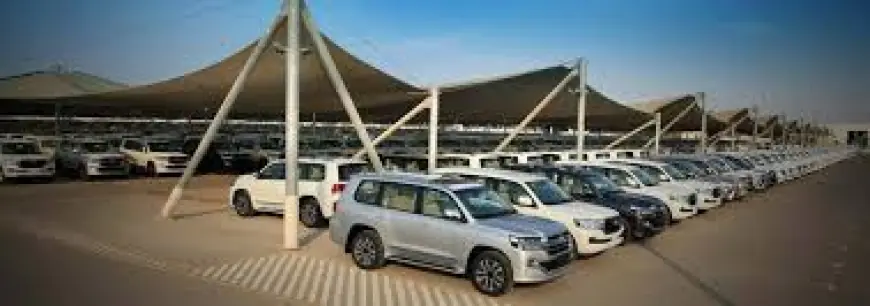Oman Automotive Market 2030: Strategic Developments
Key drivers of this market include rising investments by automakers in local dealership networks, the expansion of aftersales service infrastructure, and the rising availability of spare parts and accessories.

Introduction
The Oman automotive market is on the cusp of a significant transformation. Valued at USD 3.12 billion in 2024, the market is projected to reach USD 4.84 billion by 2030, growing at a CAGR of 7.60%. This impressive growth stems from a confluence of factors including infrastructure development, evolving consumer behavior, and regulatory reforms. Oman’s strategic goals around mobility, sustainability, and industrial diversification are further propelling market momentum.
As consumer preferences shift toward practical, durable, and technologically enriched vehicles, the automotive ecosystem in Oman is being reshaped by both global and regional trends. From increased fleet renewals to electric vehicle adoption and digital transformation of ownership processes, the market is fast adapting to changing realities.
Emerging Trends in Oman Automotive Market
1. Rise of Institutional Vehicle Procurement
The Omani automotive space is increasingly driven by institutional buyers, including logistics firms, fleet operators, and leasing companies. These entities prioritize vehicles that offer:
- Low maintenance costs
- Durability in harsh environments
- Fuel efficiency and lifecycle value
Such demand is transforming dealership strategies and influencing product offerings from manufacturers.
Download Free Sample Report: https://www.techsciresearch.com/sample-report.aspx?cid=3754
2. Electric Vehicle (EV) Adoption
Electric vehicles are gaining traction despite existing challenges like charging infrastructure and cost perceptions. Government initiatives, including preferential import duties, pilot programs, and green transport campaigns, are accelerating the shift.
Notably, EVs registered triple-digit growth in 2024, indicating that the market is readying itself for an electric future.
3. Digital Ownership Ecosystems
The digitization of processes such as:
- Vehicle registration
- Taxation
- Financing and insurance
- Service tracking
...is redefining how Omani consumers engage with the automotive industry. Mobile applications and online platforms now support maintenance scheduling, loan approvals, and real-time vehicle status updates.
4. Customization and Lifestyle Upgrades
Beyond the vehicle itself, custom accessories and aesthetic enhancements are gaining popularity. Dealerships now offer:
- Off-road kits
- Multimedia systems
- Performance upgrades
...turning the post-sale market into a significant revenue stream.
Market Drivers
1. Government Urban Development and Road Expansion
Investments in infrastructure and road connectivity—especially linking interior towns with ports and industrial zones—have increased the demand for both passenger and commercial vehicles.
2. Changing Consumer Preferences
Omani buyers are becoming more aware and selective. Factors like value-for-money, performance, and long-term ownership costs are now central to purchase decisions.
3. Accessible Financing Options
Innovative financing methods such as:
- Islamic-compliant leasing (Ijara)
- Digitized credit approvals
- Bundled insurance and fuel discounts
...are helping more people afford vehicle ownership.
4. Commercial and Industrial Growth
The expansion of free zones, logistics hubs, and industrial parks has boosted demand for both light and heavy commercial vehicles for cargo transport, workforce mobility, and utility services.
Industry Key Highlights
- The electric vehicle segment is the fastest-growing propulsion type in 2024.
- Al Batinah South led in EV adoption due to charging station deployment and targeted awareness campaigns.
- The commercial vehicle segment is benefiting from institutional fleet upgrades and increased freight movement.
- Compact SUVs and sedans remain top choices for private consumers.
- Aftermarket services—including maintenance apps and accessories—are gaining traction.
Future Outlook
Looking ahead to 2030, the Oman automotive market will continue to evolve in response to both domestic initiatives and global automotive megatrends. The future landscape will likely be shaped by:
- Acceleration of EV adoption as infrastructure gaps close and vehicle options expand.
- Integrated mobility platforms, where ownership, ride-hailing, and leasing coexist.
- Connected vehicles offering real-time diagnostics, navigation, and service alerts.
- Sustainable practices such as battery recycling, emission monitoring, and eco-friendly design.
- Localized assembly or production of certain vehicle components to support the country’s industrial goals.
By 2030, Oman could potentially emerge as a regional hub for clean transportation and smart automotive solutions.
Competitive Analysis
The Omani automotive market is home to both global and regional players. Key manufacturers are focusing on localized strategies involving brand promotions, dealer partnerships, and aftersales support. Here's a breakdown of leading players:
Top Market Players in Oman Automotive Market
- Toyota Motor Corporation – Market leader with a strong presence across segments.
- Mercedes (Daimler AG) – Focus on premium vehicles and commercial fleets.
- Nissan Motor Co. Ltd. – Known for affordability and low maintenance.
- Hyundai Motor Company – Gaining share with value-for-money offerings.
- Ashok Leyland Ltd. – Dominates the commercial vehicle segment.
- Tata Motors Ltd. – Supplies utility vehicles and small trucks.
- Hino Trucks and MAN Truck & Bus – Focused on heavy-duty logistics solutions.
- Zhengzhou Yutong Automotive Co. Ltd. – Electric bus initiatives gaining interest.
- AB Volvo – Strong brand presence in industrial fleet operations.
These companies are actively competing in areas such as product innovation, customer service, financing schemes, and green technology integration.
10 Benefits of the Oman Automotive Market Research Report
- Accurate Market Size & Forecasts (2020–2030)
Understand past performance and future trends based on quantitative data. - Detailed Segment Analysis
Get insights on vehicle types, propulsion systems, transmission types, and regional breakdowns. - Emerging Technology Trends
Analyze how EVs, connected vehicles, and digital platforms are reshaping the market. - Policy & Regulatory Impact
Evaluate how government incentives and restrictions are influencing automotive decisions. - Competitive Landscape Overview
Learn about the strategies and positioning of leading OEMs and suppliers. - Consumer Behavior Insights
Understand what drives purchasing decisions, preferences, and regional variations. - Aftermarket & Ancillary Opportunities
Discover how services like customization, insurance, and digital maintenance apps are growing. - Investment Opportunities
Identify sectors primed for business expansion or partnership—especially EV infrastructure. - Strategic Recommendations
Make informed decisions using expert-backed analysis and actionable insights. - Customization & Expert Support
The report allows tailored insights to fit business-specific needs, plus optional consulting access.
Regional Performance Focus: Al Batinah South
Al Batinah South has emerged as a leader in EV adoption. The region benefited from:
- Early installation of charging stations
- Proximity to Muscat and other urban centers
- Fleet operator pilot programs
- Strong public engagement through awareness campaigns
The model established in Al Batinah South serves as a blueprint for future EV expansion in other governorates.
Strategic Implications for Stakeholders
For Automakers:
- Increase focus on hybrid and EV models tailored to local needs.
- Partner with charging infrastructure developers to accelerate adoption.
- Launch digital-first sales and service channels.
For Dealers:
- Expand into EV accessories and maintenance.
- Offer value-added services like subscription-based car care and mobile servicing.
For Investors:
- Look into automotive fintech platforms, vehicle tracking solutions, and leasing startups.
- Evaluate partnerships with local service providers to tap into the aftermarket ecosystem.
For Policymakers:
- Extend tax benefits and incentives for low-emission vehicles.
- Implement public fleet electrification mandates.
- Create training programs for EV technicians and service engineers.
Conclusion
The Oman automotive market is no longer just about cars—it's about mobility evolution. With structural changes in urban design, consumer aspirations, and industrial policy, Oman is moving toward a future defined by connected, clean, and convenient transportation.
As the country gears up for Vision 2040, mobility solutions will play a pivotal role in transforming its socio-economic landscape. Stakeholders across the value chain—manufacturers, regulators, dealers, and consumers—are all contributors to this remarkable transition.
The market offers ample growth, innovation, and investment potential. For those prepared to embrace change and think ahead, Oman’s automotive sector offers a roadmap full of opportunities.
Contact Us-
Mr. Ken Mathews
708 Third Avenue,
Manhattan, NY,
New York – 10017
Tel: +1-646-360-1656
Email: [email protected]
Website: www.techsciresearch.com
What's Your Reaction?
 Like
0
Like
0
 Dislike
0
Dislike
0
 Love
0
Love
0
 Funny
0
Funny
0
 Angry
0
Angry
0
 Sad
0
Sad
0
 Wow
0
Wow
0


















































